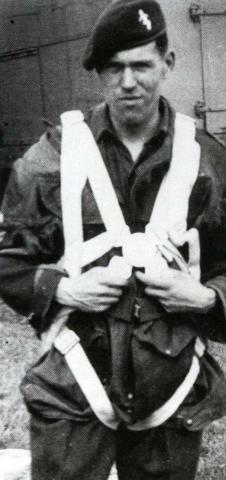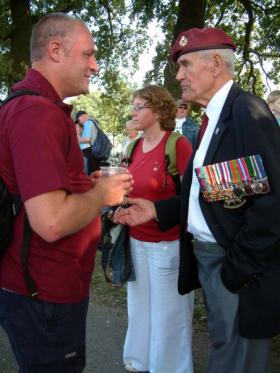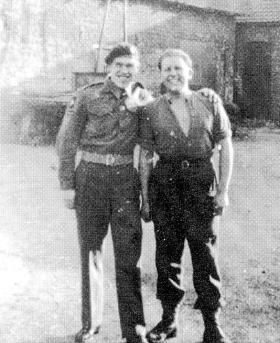Ron Jordan was born on 5 September 1920 at Aston in Birmingham.
Ron joined the Army prior to 1942, serving with the Royal Corps of Signals before transferring to the Royal Electrical and Mechanical Engineers and training as an Armourer.
He volunteered for airborne forces and saw service in North Africa and Italy, from May to December 1943. He then returned to the UK and the 1st Airborne Division Advanced Workshop Detachment settled down in the Lincolnshire town of Sleaford, where it remained for over 8 months.
Ron flew to Arnhem, from RAF Down Ampney, in Horsa glider No 3 of the Advanced Workshop Detachment on Monday, 18 September 1944. This was part of the second lift and he landed successfully at LZ X near Heelsum and Wolfheze.
By Tuesday, 19 September the Advanced Work Shop Detachment, REME was already firmly established near the Hartenstein Hotel, where it remained throughout the rest of the battle.
'There was plenty going on around this time. Captain Ewens, Adjutant to the Commander REME, sent a message over from Divisional HQ requesting an armourer to report to him. Craftsman Ron Jordan was sent over and was given the task of inspecting and servicing a real piece of history in the shape of a World War One Vickers machine-gun, the object being to see if it could be used. The relic had been found outside the Divisional HQ; which was previously tenanted by Germans who beat a hasty retreat when the first lift arrived. To his surprise, Craftsman Jordan found the weapon in excellent condition and it was handed back to the Captain, for onward transmission to one of the Battalions.' [1]
Ron’s own personal recollection of the battle:
“I thought they had thrown everything at us during that fateful week, so free elocution lessons on Sunday 24 September 1944, on the steps of Div HQ, were quite unexpected.
Landing on Monday 18 as a REME tradesman and converted to an Infantryman the next day in an assorted group commanded by Major Royle, GPR our positions varied from the crossroads to the Tafelberg.
At dusk on the Sunday we were attacked and one of our group was severely wounded in the groin and refused to go to the Tafelberg as it was under German control so we decided to get him to the aid post at Divisional HQ, but first we had to find a stretcher.
We saw a medic in the dark cellars who said all the stretchers were in use but went to check on some of the wounded. One of them had died and he said we could have the stretcher but we had to take the dead soldier and place him with the other dead around the corner of the hotel.
When we came to take the stretcher away it was full of congealed blood, we were tipping it over when a Sergeant Major came out of Divisional HQ, ordered us to drop the stretcher and man the door as an attack was expected. We thought 'here we go again' and when we got inside, the place was a complete shambles with glass, plaster and kit strewn everywhere. All the windows were blown in and an almighty stench was coming from what I guess was the toilet. The Sergeant Major said he would go to the front window and warn us if he saw them coming and told us the good news; we were the only men there.
Raid or no raid we couldn’t resist having a look around for food, water or ammo but our luck was out, we found nothing but shaving kit. After about 20 minutes of acute trepidation a jeep came round the corner and fortunately the passenger was wearing a red beret. It stopped at the bottom of the steps and the passenger got out. When he was on the bottom step I challenged him with the password 'Mae', he turned back and dived underneath the jeep together with the driver. I couldn’t see what they were playing at as I had them well covered; I then heard one of them say they must have got Div HQ – on hearing this I shouted 'Come out, you silly buggers!' One of them came bounding up the steps and I told him in no uncertain terms how lucky he was not to have been shot.
I was very tired having spent the previous night on a nightmare patrol and wanting to get the stretcher back I was not in the best of moods. Then this little man started to rip me off, well I thought he must have burnt his behind on the exhaust when he dived under the jeep, his main point seeming to be I had said 'Nein'. Things were starting to get out of hand when the Sergeant Major intervened and told me to salute the Brigadier, who then made me pronounce Mae over and over again, he then told the Sergeant Major to find another sentry. After he had gone the Sergeant Major told us to get back to our positions pronto. We duly obliged. After all this time I still don’t think my Brummy accent was that bad nor did I expect to get elocution lessons in the middle of a battle.”
Ron was wounded (by shrapnel in both sides of his body) and taken prisoner at the end of the battle, whilst they were withdrawing down to the river on the night of 25/26 September 1944. He was initially taken to the St Elizabeth Hospital in Arnhem for treatment and then moved to the ‘Airborne Hospital’ at Apeldoorn.
He eventually left Apeldoorn, on 3 October 1944, as walking wounded and was taken by cattle train to Stalag XIB at Falingbostel.
After retirement Ron joined the Arnhem 1944 Veterans Club (AVC), in fact he was one of the first 700 to join, out of the several thousand survivors of the battle that eventually became members. In the 1990s he became the Midland Regional Representative for the AVC. He attended many of the pilgrimages to Arnhem/Oosterbeek.
Ron died at his home on 10 March 2013, aged 92.
[1] ‘WITH SPANNERS DESCENDING’ A History of the Royal Electrical and Mechanical Engineers with 1st Airborne Division: 1942-1945. By Joe Roberts.
Bob Hilton
Read More






Latest Comments
There are currently no comments for this content.
Add Comment
In order to add comments you must be registered with ParaData.
If you are currently a ParaData member please login.
If you are not currently a ParaData member but wish to get involved please register.